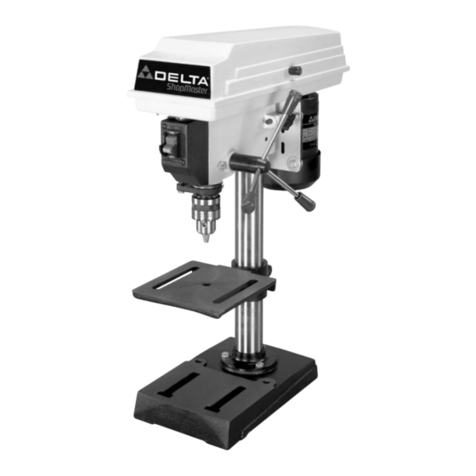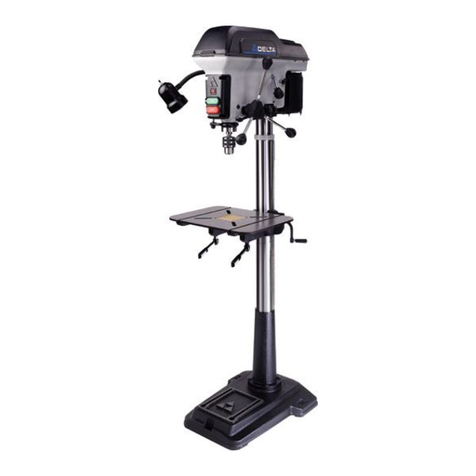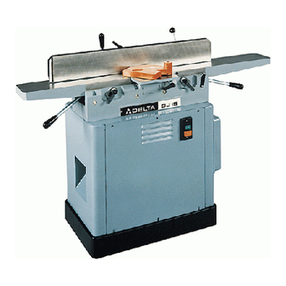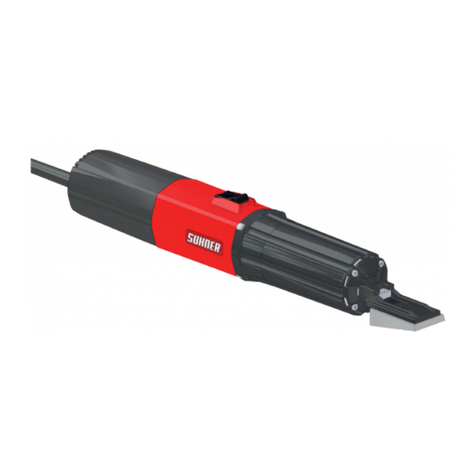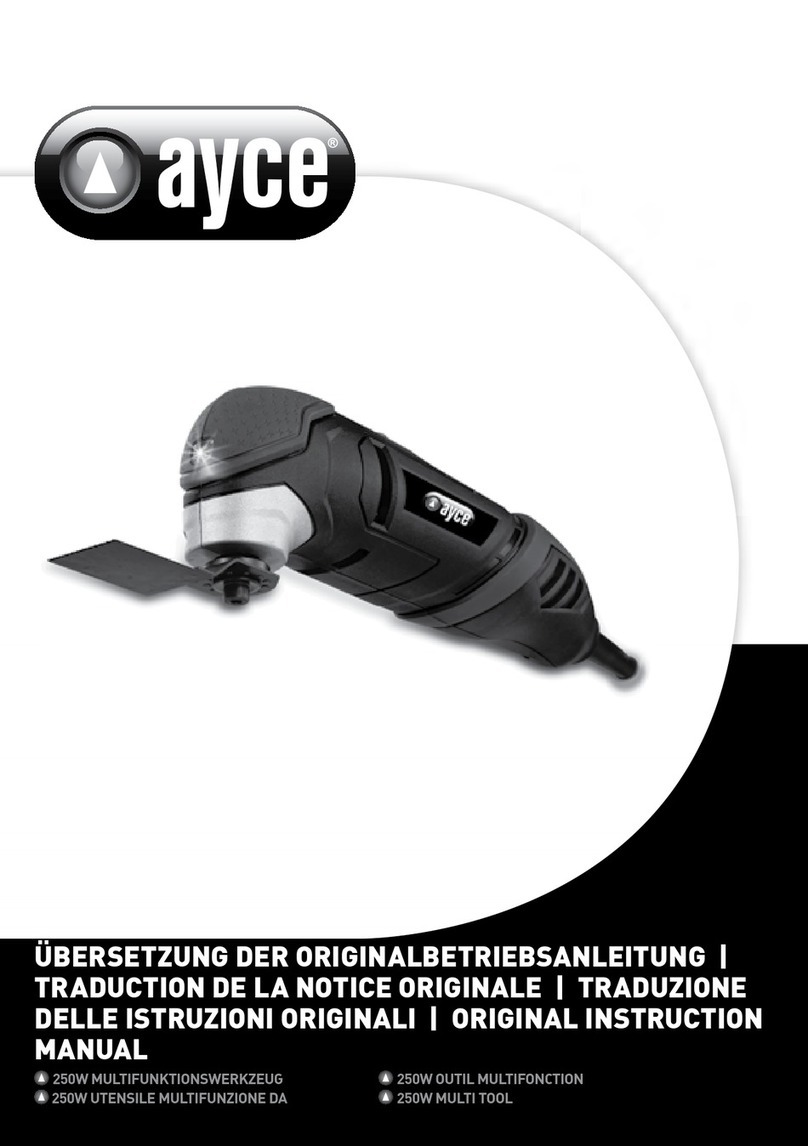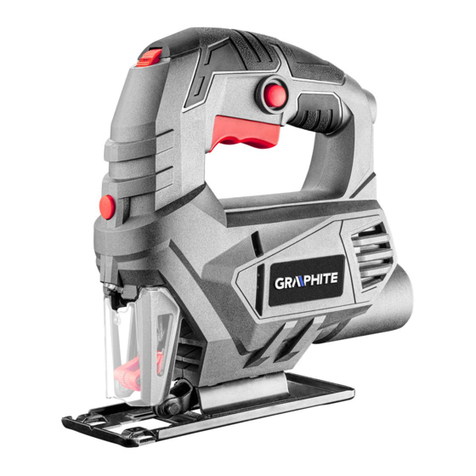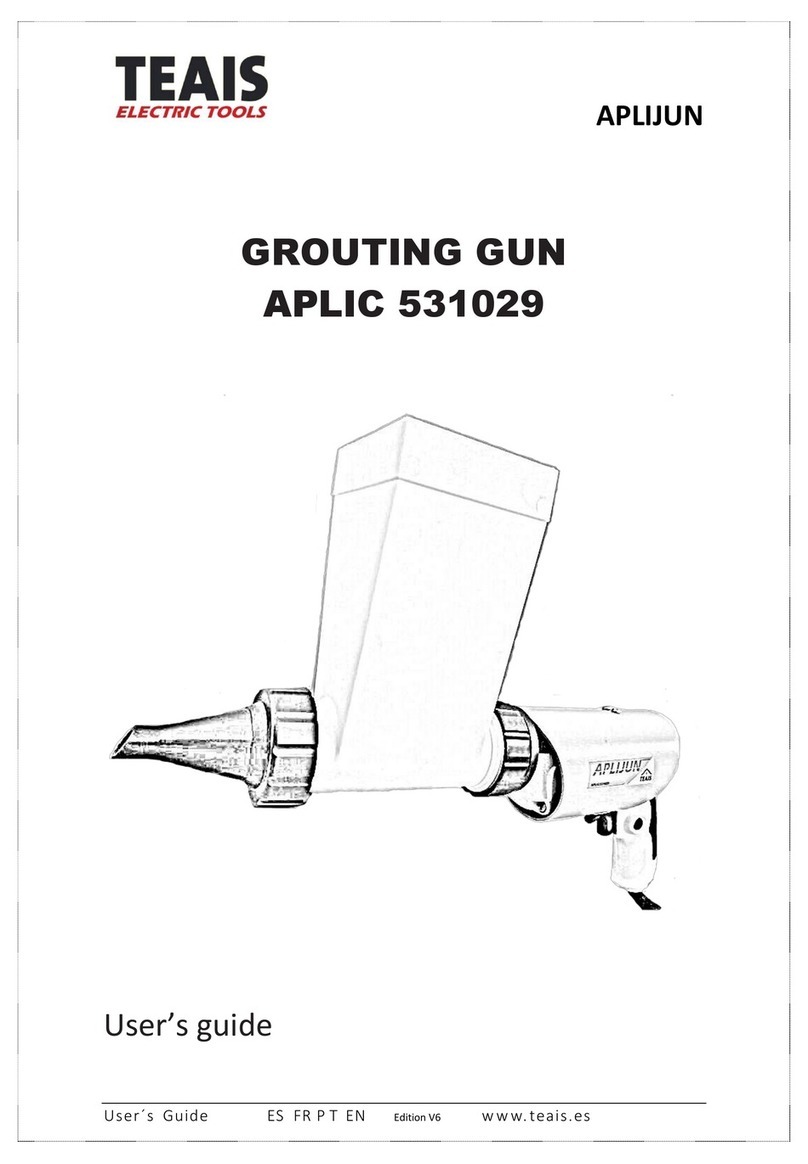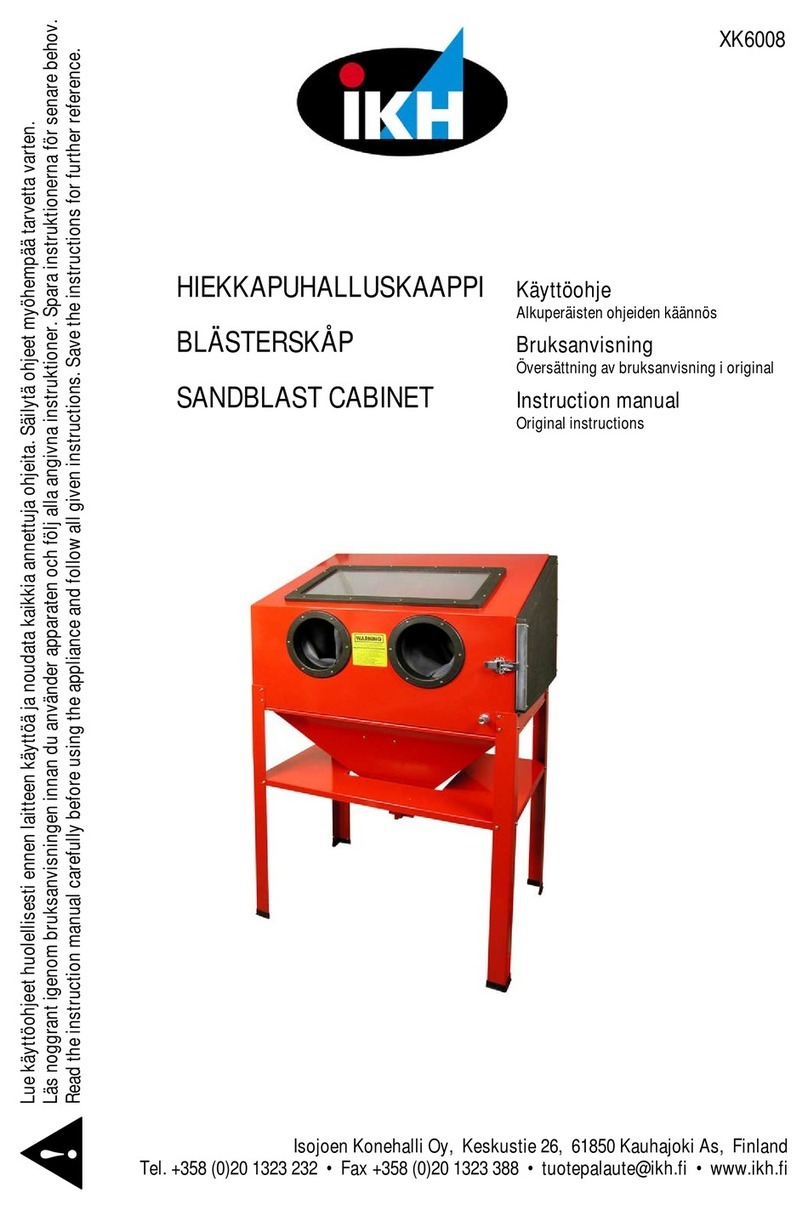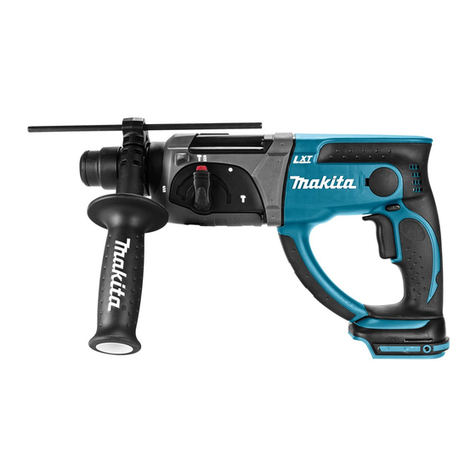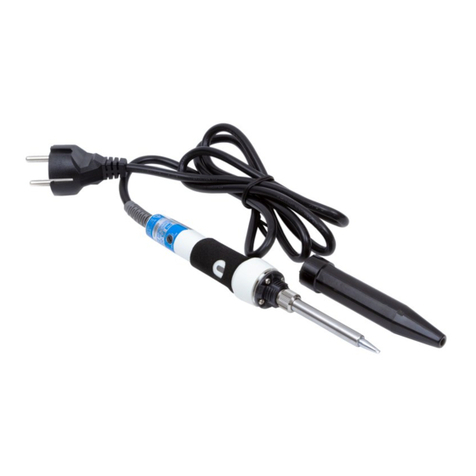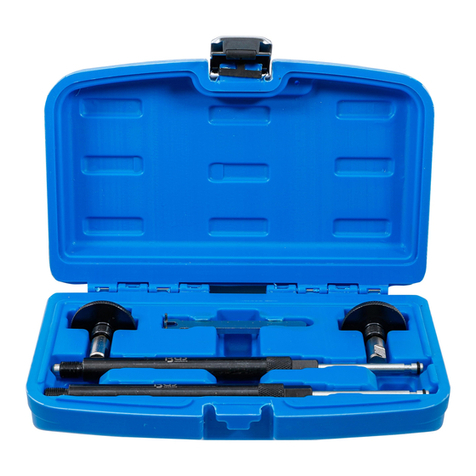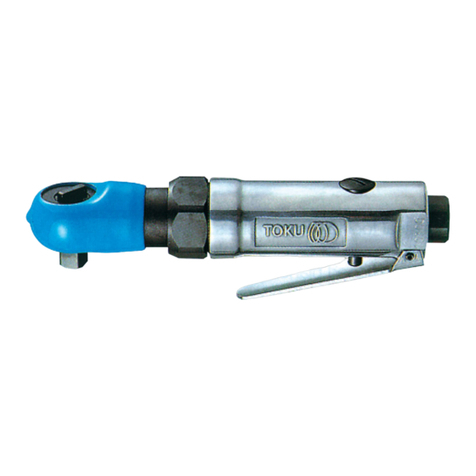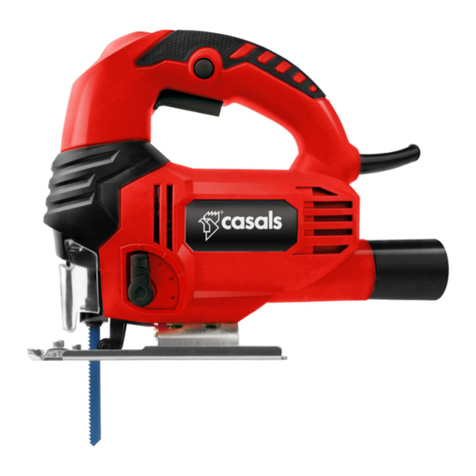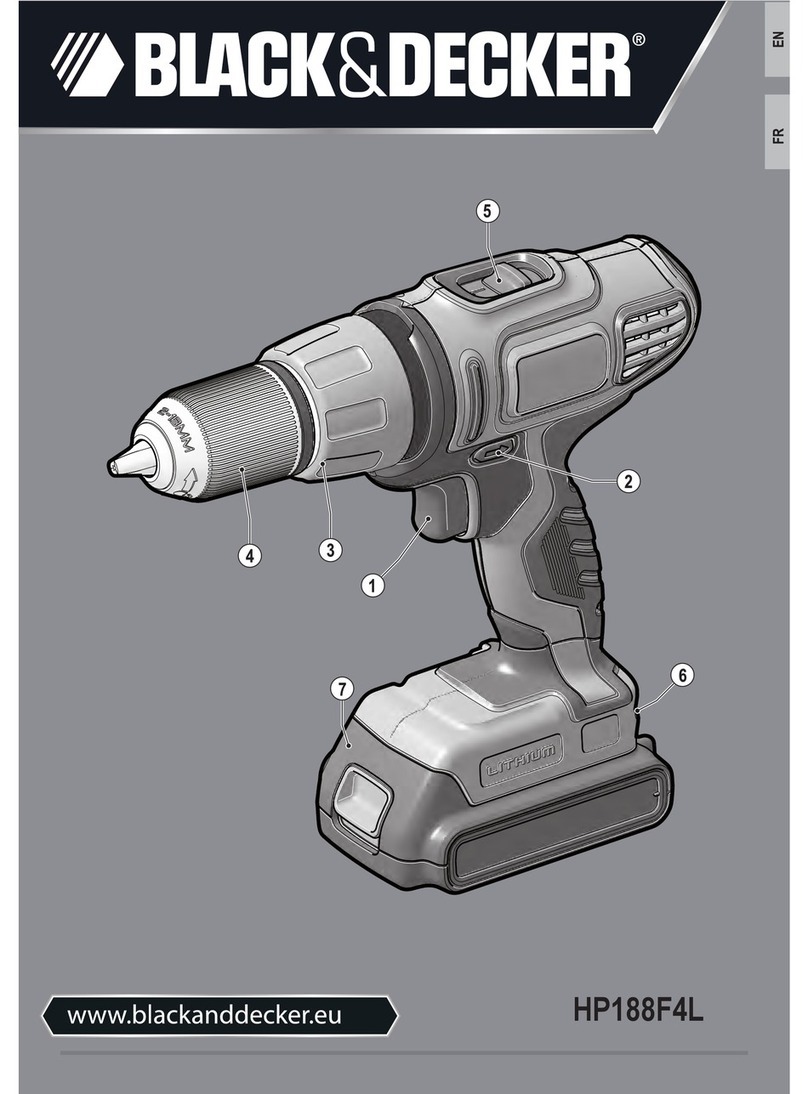Delta 37-285 User manual

INSTRUCTION MANUAL
D AT E D 1-20-99 PA RT NO. 1347169
'Delta International Machinery Corp. 1999
6 Motorized Jointer
(Model 37-285)
Record this information for future
reference.
SERIAL NO._____________________
DATE OF PURCHASE ____________
See Table of Content s for location of
Serial No.

2
TABLE OF CONTENTS
SAFETY RULES ...............................................................................................................................................................3
ADDITIONAL SAFETY RULES FOR JOINTERS.............................................................................................................4
DEFINITIONS O F JOINTING & PLANING OPERATIONS...............................................................................................5
UNPACKING AND CLEANING.........................................................................................................................................6
ASSEMBLY INSTRUCTIONS ...........................................................................................................................................7
Assembling Stand...................................................................................................................................................7
Assembling Stand And Dust Chute To Jointer ....................................................................................................8
Assembling Belt And Pulley Guard.......................................................................................................................8
Assembling Motor Pulley Guard ...........................................................................................................................9
Assembling Fence Assembly To Jointer ..............................................................................................................9
Assembling Cutterhead Guard ............................................................................................................................10
EXTENSION CORDS......................................................................................................................................................11
CONNECTING JOINTER TO POWERSOURCE...........................................................................................................11
Power Connections...............................................................................................................................................11
Grounding Instructions ........................................................................................................................................11
OPERATING CONTROLS AND ADJUSTMENTS
On/Off Switch ........................................................................................................................................................12
Locking Switch In The OFF Position ...............................................................................................................12
Overload Protection ..............................................................................................................................................12
Knife And Table Adjustments ..............................................................................................................................12
Adjusting Depth-Of-Cut ........................................................................................................................................14
Fence Adjustments ...............................................................................................................................................14
OPERATIONS
Placement of Hands During Feeding ..................................................................................................................15
Jointing A n Edge...................................................................................................................................................16
Planing Or Surfacing ............................................................................................................................................16
Beveling .................................................................................................................................................................17
Taper Cuts..............................................................................................................................................................17
Cutting A Rabbet ...................................................................................................................................................17
Planing Warped Pieces.........................................................................................................................................18
Planing Short Or Thin Work .................................................................................................................................18
Direction Of Grain .................................................................................................................................................18
MAINTENANCE AND REPAIRS
Whetting Knives ....................................................................................................................................................18
Removing, Replacing, And Resetting Knives ....................................................................................................19
Blade Care .............................................................................................................................................................20
IDENTIFICATION PL ATE................................................................................................................................................20
CONSTRUCTING A PUSH STICK .................................................................................................................................21
W ARRANTY....................................................................................................................................................................22

3
SAFETY RULES
W oodworking can be dangerous if safe and proper operating procedures are not followed. As with all machinery, there are cert ain
hazards involved with the operation of the product. Using the machine with respect and caution will considerably lessen the possi -
bility of personal injury . However, if normal safety precautions are overlooked or ignored, personal injury to the operator may result.
Safety equipment such as guards, push sticks, hold-downs, featherboards, goggles, dust masks and hearing protection can reduce
your potential for injury . But even the best guard won t make up for poor judgment, carelessness or inattention. Always use common
sense and exercise caution in the workshop. If a procedure feels dangerous, don t try it. Figure out an alternative procedure that feels
safer . REMEMBER: Your personal safety is your responsibility.
This machine was designed for cert ain applications only. Delt a Machinery strongly recommends that this machine not be modified
and/or used for any application other than that for which it was designed. If you have any questions relative to a p articular applica -
tion, DO N O T use the machine until you have first cont acted Delt a to determine if it can or should be performed on the product.
DELTA INTERNATIONAL MACHINERY CORP.
MANAGEROF TECHNICAL SERVICES
246 ALPHA DRIVE
PITTSBURGH, PENNSYLVANIA 15238
(IN CANADA: 644 IMPERIAL ROAD, GUELPH, ONTARIO N1H 6M7)
W ARNING: FAILURE TO FOLLOW THESE RULES
M AY RESULT IN SERIOUS PERSONAL INJURY
1. FOR YOUR O W N SAFETY, READ INSTRUCTION
MANUAL BEFORE OPERATING THE TO O L. Learn the
tool s application and limit ations as well as the specific
hazards peculiar to it.
2. KEEP GUARDS IN PLACE and in working order .
3. ALWAYSWEAREYEPROTECTION.
4. REMOVE ADJUSTING KEYS AND WRENCHES. Form
habit of checking to see that keys and adjusting wrenches are
removed from tool before turning it on.
5. KEEP WORKAREA CLEAN. Cluttered areas and
benches invite accident s.
6. DON T USE IN DANGEROUS ENVIRONMENT. Don t
use power tools in damp or wet locations, or expose them
to rain. Keep work area well-lighted.
7. KEEP CHILDREN A N D VISIT O R S A W A Y . All children
and visitors should be kept a safe dist ance from work area.
8. MAKEWORKSHOP CHILDPROOF with p adlocks,
master switches, or by removing st arter keys.
9. DON T FORCE TO O L. It will do the job better and be
safer at the rate for which it was designed.
10. US E RIGHT TO O L.Don tforce tool or att achment to do
a job for which it was not designed.
11. WEARPROPER APPAREL.No loose clothing, gloves,
neckties, rings, bracelet s, or other jewelry to get caught in
moving parts. Nonslip footwear is recommended. Wear
protective hair covering to cont ain long hair .
12. ALW AYS USE SAFETY GLASSES.W ear safety glasses.
Everyday eyeglasses only have impact resist ant lenses;
they are not safety glasses. Also use face or dust mask if
cutting operation is dusty.
13. SECURE WORK. Use clamp s or a vise to hold work
when practical. It s safer than using your hand and frees
both hands to operate tool.
14. DON T OVERREACH. Keep proper footing and balance
at all times.
15. MAINTAIN TOOLS IN TOP CONDITION. Keep tools
sharp and clean for best and safest performance. Follow
instructions for lubricating and changing accessories.
16. DISCONNECT TOOLS before servicing and when
changing accessories such as blades, bit s, cutters, etc.
17. USE RECOMMENDED ACCESSORIES. The use of
accessories and att achments not recommended by Delt a
may cause hazards or risk of injury to persons.
18. REDUCE THE RISK O F UNINTENTIONAL START-
I N G . Make sure switch is in OFF position before plugging
in power cord.
19. NEVER STAND O N TOOL. Serious injury could occur
if the tool is tipped or if the cutting tool is accident ally
cont acted.
20. CHECK DAMAGED PARTS. Before further use of the
tool, a guard or other p art that is damaged should be care -
fully checked to ensure that it will operate properly and
perform it s intended function check for alignment of moving
part s, binding of moving p art s, breakage of p art s, mounting,
and any other conditions that may af fect it s operation. A
guard or other p art that is damaged should be properly
rep aired or replaced.
21. DIRECTION O F FEED.Feed work into a blade or cutter
against the direction of rot ation of the blade or cutter only.
22.
NEVER LEAVE TOOL RUNNING UNATTENDED. TURN
POWEROFF
. Don t leave tool until it comes to a complete
stop.
23. DRUGS, ALCOHOL, MEDICATION. Do not operate
tool while under the influence of drugs, alcohol or any
medication.
24. MAKESURE TOOL IS DISCONNECTED FROM POWER
SUPPLY
while motor is being mounted, connected or re-
connected.
25. W ARNING: The dust generated by certain woods and
wood products can be injurious to your health. Always oper-
ate machinery in well ventilated areas and provide for proper
dust removal. Use wood dust collection systems whenever
possible.

4
ADDITIONAL SAFETY RULES FOR
JOINTERS
1. W ARNING: Do not operate the jointer until it is
completely assembled and inst alled according to the
instructions.
2.IFYOU ARE NOT thoroughly familiar with the oper-
ation of jointers, obt ain advice from your supervisor ,
instructor or other qualified person.
3. KEEP cutterhead sharp and free of all rust and pitch.
4. BEFORE starting machine, check cutterhead guard
to make sure it is not damaged and operates freely.
5. A LW A Y S make sure exposed cutterhead behind the
fence is guarded, especially when jointing near the edge.
6. NEVER perform jointing or planing operations with
the cutterhead guard removed.
7. MAKE CERTAIN the infeed and out feed t ables are
tightened before st arting the machine.
8. NEVER st art the jointer with the workpiece cont act -
ing the cutterhead.
9. A L W A Y S hold the workpiece firmly against the
tables and fence.
10. NEVER perform any operation Free-hand which
means using your hands to support or guide the work -
piece. A LW A YS use the fence to position and guide the
work.
11. A VOID awkward operations and hand positions
where a sudden slip could cause your hand to move into
the cutterhead.
12. A LW A Y S use hold-down/push blocks for jointing
material less than 3 inches in height or planing material
thinner than 3 inches.
13. D O N O T perform jointing operations on material
shorter than 10 inches, narrower than 3/4 inch or less
than 1/2 inch thick.
14. D O N O T perform planing operations on material
shorter than 10 inches, narrower than 3/4 inch, wider
than 6 inches or less than 1/2 inch thick.
15. NEVER make jointing or planing cut s deeper than
1/8 inch. On cut s more than 1-1/2 inches wide, adjust
depth of cut to 1/16 inch or less to avoid overloading
machine and to minimize chance of kick-back (work
thrown back toward you).
16. MAINTAIN the proper relationship of infeed and out -
feed t able surfaces and cutterhead knife p ath.
17. SUPPORT the workpiece adequately at all times
during operation; maint ain control of the work at all times.
18. D O N O T back the workpiece toward the infeed t able.
19. D O N O T attempt to perform an abnormal or little-
used operation without study and the use of adequate
hold-down/push blocks, jigs, fixtures, stop s, push blocks,
etc.
20. SHUT OFF power before servicing or adjusting jointer.
21. DISCONNECT jointer from power source and clean
the machine before leaving it.
22. MAKE SURE the work area is clean before leaving
the machine.
23. SHOULD any p art of your jointer be missing, dam -
aged, or fail in any way, or any electrical component fail
to perform properly, shut of f switch and remove plug from
power supply outlet. Replace missing, damaged or failed
part s before resuming operation.
24. THE USE ofattachments and accessories not recom-
mended by Delta may result in the risk of injuiries.
25. ADDITIONAL INFORMATION regarding the safe
and proper operation of this product is available from the
National Safety Council, 1121 Spring Lake Drive, It asca,
IL 60143-3201 in the Accident Prevention Manual for
Industrial Operation and also in the Safety Dat a Sheet s
provided by the NSC. Please also refer to the American
National Standat d Institute ANSI 01.1 Safety
Requirements for W oodworking Machinery and the U.S.
D e partment of Labor OSHA 1910.213 Regulations.
26. S AVE THESE INSTRUCTIONS. Refer to them of ten
and use them to instruct others.

5
DEFINITIONS O F JOINTING AND PLANING
OPERATIONS
Jointing Operations - Jointing cut s or edge jointing is the simplest and most common operation which can be done on
the jointer and these cut s are made to square an edge of a workpiece. The fence is square with the t able and the depth
of cut is approximately 1/8 inch. The workpiece is positioned on the jointer with the narrow edge of the workpiece on the
infeed t able and the major flat surface of the workpiece against the fence, as shown in Fig. 2. The workpiece is moved
from the infeed t able, across the cutterhead to the out feed t able. The hand over the out feed t able presses the work down
so that the newly-formed surface will make perfect cont act with the t able. The hand over the infeed t able (usually the
right hand) exert s no downward pressure, but simply advances the work to the cutterhead. Both hands exert pressure
to keep the work in cont act with the fence.
Planing Operations - Planing or surfacing are identical to the jointing operation except for the position of the workpiece.
For planing, the major flat surface of the workpiece is placed on the infeed t able of the jointer with the narrow edge of the
workpiece against the fence, as shown in Fig. 3. The workpiece is moved from the infeed t able, across the cutterhead to
the out feed t able est ablishing a flat surface on the workpiece. Always use push blocks when performing planing operations.
Fig. 3
Fig. 2

6
Fig. 4
1. Jointer
2. Belt and Pulley Guard
3. 1/4-20 x 1/2 T russ Head
Screw (2)
4. Guard
5. #8-32 x 1/4 Round Head
Screw
6. Flat Washers (2)
7. #8-32 Hex Nut
8. Dust Chute
9. Cutterhead Guard
UNPACKING A N D CLEANING
The 6 Motorized Jointer is shipped complete in one cont ainer . Carefully unp ack the jointer , st and, and all loose items
from the cont ainer . Figs. 4 and 5 illustrate the items supplied with the jointer .
1. W ARNING: For your own safety, DO NOT connect the jointer to a power source until the machine is completely
assembled and you have read and understood the entire owner s manual.
2. IMPORTANT:When removing the jointer from the shipping cont ainer , D O N O T place the jointer on a flat surface.
Support the jointer at both ends with 4 x 4 lumber or similar material, as shown in Fig. 4. This will prevent any dam -
age to the motor assembly, which is located on the base of the jointer .
3. CAUTION: Carefully remove the protective coating from the machined surfaces of the jointer. D O N O T let your
hands or fingers come in cont act with the cutterhead knives as they are extremely sharp. D O N O T use acetone, gaso-
line or lacquer thinner to clean the jointer; use a sof t cloth moistened with kerosene. Af ter cleaning, cover the t able sur -
face with a good quality p aste wax.
10. Fence Mounting Bracket
Assembly
11. Locking Lever
12. Flat Washer
13. 1/4-20 x 3/4 Flat Head
Screws (2)
14. Flat Washers (2)
15. 1-1/4-20 Hex Nuts (2)
16. Fence Support Bracket
17. Cap Screws (2)
18. 5/16-18 x 1-1/4 Hex Head
Screws (3)
19. Flat Washers (6)
20. 5/16 Hex Nuts (3)
21. Push Blocks (2)
22. Fence
23. Flat Washers (2)
24. 1/4-20 x 3/4 Square Head
Screws
25. W renches (4): 2.5, 5, 6mm
and 8/10mm Open-end
1
18
20
19
17
21
22
16
25
23
24
9
8
2
12
11
15
10
14
13
3
4
5
7
6

7
26. Legs for Stand (4)
27. Two Top End Braces for Stand
(10-1/2 long)
28. Two Bottom End Braces for
Stand (15-1/2 long)
Fig. 5
ASSEMBLY INSTRUCTIONS
Fig. 6
29. Top Front and Rear Braces
for S tand (25-1/2 long)
30. Bottom Front and Rear Braces
for S tand (30-1/2 long)
31. Four Feet for S tand Legs
ASSEMBLING STAND
MAKECERTAIN THE MACHINE IS DISCONNECTED
FROM THE POWER SOURCE AND THAT KNIFE
GUARD(A)FIG. 13, IS POSITIONED OVER THE CUT-
TERHEAD.
1. Assemble two top end braces (A) Fig. 6, two top
braces (B) and (C), two lower end braces (D), and two
lower side braces (E) to the four legs (F) as shown using
thirty-two 1/2 long carriage bolt s, flat washers, and hex
nut s.Only tighten hex nut s fingertight at this time .
IMPORTANT:The top lip s of the two upper end braces
(A) must fit on top of two upper side braces (B) and (C).
NOTE: The one top brace (B) with the slotted edge will
be at the rear of the jointer when it is assembled.
2. Assemble the four rubber feet (G) Fig. 6, to the bot -
tom of each leg.
W ARNING: FOR YOUR OWN SAFETY, DO NOT CONNECT THE JOINTER TO THE POWER SOURCE UNTIL
THE JOINTER IS COMPLETELY ASSEMBLED AND YOU HAVE READ AND UNDERSTOOD THE ENTIRE
OWNERS MANUAL.
32. 1/2 Long Carriage Bolt s for
Stand (32)
33. Flat Washers for Stand (32)
34. Hex Nuts for S tand (32)
26
32
33
34
31
30
28
27
29
BCA
D
F
G
E
D
A

8
ASSEMBLING STAND AND
DUST CHUTE TO JOINTER
MAKECERTAIN THE MACHINE IS DISCONNECTED
FROM THE POWER SOURCE AND THAT KNIFE
GUARD(A)FIG.13, IS POSITIONED OVER THE CUT-
TERHEAD.
1. Carefully turn the jointer (A) Fig. 7, up side-down so
the t able is resting on a supporting surface similar to the
two pieces of 4 x 4 lumber as shown. This will facili-
tate the assembly of the dust chute (B) Fig. 8, and st a n d
(C) to the jointer .
2. Align the three mounting holes (D) Fig. 8, in the st a n d
with three mounting holes in the base of the jointer as
shown in Fig. 8.
ASSEMBLING BELT
AND PULLEY GUARD
MAKECERTAIN THE MACHINE IS DISCONNECTED
FROM THE POWER SOURCE AND THAT KNIFE
GUARD(A)FIG.13, IS POSITIONED OVER THE CUT-
TERHEAD.
1. Loosely thread two 1-1/4-20 x 1/2 truss head
screws (A) Fig. 10, into the two t apped holes at the rear
of the jointer t able.
2. Insert slot s in guard (B) under heads of screws (A)
as shown in Fig. 1 1, and tighten screws to hold guard in
position.
Fig. 7
Fig. 8
Fig. 10Fig. 9
Fig. 1 1
3. Position dust chute (B) Fig. 9, as shown, over two of
the holes (D) that were aligned in STEP 2.
4. Assemble the dust chute (B) and st and (C) Fig. 9, at
each hole (D) with a 5/16-18 x 1-1/4 long hex head
screw (E), two flat washers (F), and hex nut (G). NOTE:
Screws are to be inst alled upward from the base of the
jointer .
5. Carefully turn the jointer with st and and dust chute
att ached so the jointer is resting on the st and. IMPOR-
TA N T: W e strongly suggest that two people perform this
operation.
6. Apply downward pressure on the jointer so the legs
of the st and are adjusted to the floor surface and tighten
allstand mounting hardware.
A
BC
A
D
D
D
D
D
F
E
G
D
C
B
A
A
B

9
Fig. 12
Fig. 13
Fig. 15
Fig. 14
ASSEMBLING M O TO R
PULLEY GUARD
MAKECERTAIN THE MACHINE IS DISCONNECTED
FROM THE POWER SOURCE AND THAT KNIFE
GUARD(A)FIG.13, IS POSITIONED OVER THE CUT-
TERHEAD.
1. Assemble motor pulley guard (C) Fig. 12, soitfits
a round the out side of the belt and pulley guard (B). Fasten
the motor pulley guard (C) Fig. 12, to the side of the st a n d
with #8-32 x 1/4 round head screw (D), two flat wash -
ers, and hex nut.
ASSEMBLING FENCE
ASSEMBLY TO JOINTER
MAKECERTAIN THE MACHINE IS DISCONNECTED
FROM THE POWER SOURCE AND THAT KNIFE
GUARD(A)FIG.13, IS POSITIONED OVER THE CUT-
TERHEAD.
1. Position fence slide bracket (B) Fig. 13, over the two
threaded holes (C) at the rear of the jointer and fasten
the support bracket with two cap screws (D) and supplied
wrench (E).
2. Place fence support bracket (F) Fig. 14, over rod in
slide bracket assembly (B) and fasten with flat washer
and locking lever (G).
3. Fig. 15, illustrates the slide and support bracket s
assembled to the jointer.
4. Align the two holes in the fence support bracket (H)
Fig. 15, with two holes (J) in fence (K) and carefully
fasten the fence to the fence support bracket with two flat
washers and 1/4-20 x 3/4 square head screws (L) as
shown in Fig. 16.
D
C
B
A
E
D
CB
F
G
B
H
G
L
J
K

10
ASSEMBLING
CUTTERHEAD GUARD
MAKECERTAIN THE MACHINE IS DISCONNECTED
FROM THE POWER SOURCE AND THAT KNIFE
GUARDIS POSITIONED OVER THE CUTTERHEAD.
1. Remove set screw (A) Fig. 17, from the post of the
cutterhead guard (B) with supplied wrench (C).
Fig. 16
Fig. 17
Fig. 18
Fig. 19
5. Assemble the free end of spring (M) Fig. 16, onto the
rear edge of bracket (F). NOTE: The tension on spring
(M) Fig. 16, automatically allows safety guard (N) to move
forward with the fence (K) and over the rear of the cutter-
head for operator safety.
6. IMPORTANT:REMOVE KNIFE GUARD FROM
CUTTERHEAD ASSEMBLY.
F
M
2. Insert the post of cutterhead guard (B) Fig. 18, down
through hole (D) in the infeed t able. NOTE: A spring is
supplied inside knob assembly (E) Fig. 18, that returns
guard (B) over the cutterhead af ter the cut has been
made. Turn knob (E) Fig. 18, to provide tension on the
spring before inserting the post. Make certain the
spring inside knob (E) engages slot in cutterhead
post and that the guard (B) is positioned over pin (F) .
If spring tension is too much or too little, adjust the
tension spring accordingly by removing the guard and
rot ating knob (E).
3. Thread set screw (A) Fig. 19, which was removed in
STEP 1, back into post to keep cutterhead guard (B) in
position during jointer operation.
4. Fig. 19, illustrates the cutterhead guard (B) assem -
bled to the infeed t able. NOTE: When installed correctly ,
the guard should spring back over the cutterhead af ter
the cut.
B
A
C
B
FD
E
B
N
K
A

11
EXTENSION CORDS
Use proper extension cords. Make sure your extension
cord is in good condition and is a 3-wire extension cord
which has a 3-prong grounding type plug and a 3-pole
recept acle which will accept the tool s plug. When using
an extension cord, be sure to use one heavy enough to
carry the current of the jointer . An undersized cord will
cause a drop in line volt age, resulting in loss of power
and overheating. Fig. 20 shows the correct gage to use
depending on cord length. If in doubt, use the next heavie r
gage. The smaller the gage number, the heavier the cord . Fig. 20
TOTAL LENGTH OF
CORDINFEET
0 - 25
26 - 50
51 - 100
101 - 150
GAGEOFEXTENSION
CORDTO USE
16 A W G
16 A W G
14 A W G
12 A W G
CONNECTING JOINTER TO POWERSOURCE
POWERCONNECTIONS
A sep arate electrical circuit should be used for your tools. This circuit should not be less than #12 wire and should be
protected with a 20 Amp fuse. Have a certified electrician replace or rep air a worn cord immediately. Before connecting
the motor to a power line, make sure the switch is in the OFF position and be sure that the electric current is of the
same characteristics as st amped on the motor nameplate. Running on low volt age will damage the motor.
W ARNING: D O N O T EXPOSE THE TOOL TO RAIN O R OPERATE THE TOOL IN DAMP LOCATIONS.
GROUNDING INSTRUCTIONS
This tool is intended for use on a circuit that has an out -
let and a plug that looks like the one shown in Fig. 21.
A temporary adapter, which looks like the adapter illus -
trated in Fig. 22, may be used to connect this plug to a
2-pole recept acle, as shown in Fig. 22, if a properly
grounded outlet is not available. The temporary adapter
should be used only until a propery grounded outlet can
inst alled by a qualified electrician. THIS ADAPTER IS
NOT APPLICABLE IN CANADA. The green-colored
rigid ear , lug, and the like, extending from the adapter ,
must be connected to a permanent ground, such as a
properly grounded outlet box, as shown in Fig. 22.
CAUTION: IN ALL CASES, MAKE CERTAIN THE RECEP-
TACLE IN QUESTION IS PROPERLY GROUNDED.
IF Y O U ARE NOT SURE, HAV E A CERTIFIED ELEC-
TRICIAN CHECK THE RECEPTACLE.
In the event of a malfunction or breakdown, grounding
provides a p ath of least resist ance for electric current to
reduce the risk of electric shock. The motor is equipped
with an electric cord having an equipment-grounding
conductor and a grounding plug. The plug must be
plugged into a matching outlet that is properly inst alled
and grounded in accordance with all local codes and
ordinances.
Do not modify the plug provided - if it will not fit the outlet,
have the proper outlet inst alled by a qualified electrician.
Improper connection of the equipment-grounding conduc -
tor can result in risk of electric shock. The conductor with
insulation having an outer surface that is green with or
without yellow stripes is the equipment-grounding conduc -
tor. Ifrep air or replacement of the electric cord or plug is
necessary, do not connect the equipment grounding con -
ductor to a live terminal. Check with a qualified electrician
or service personnel if the grounding instructions are not
completely understood, or if in doubt as to whether the
tool is properly grounded.
Use only 3-wire extension cords that have 3-prong
grounding type plugs and 3-hole recept acles that accept
the tool s plug, as shown in Fig. 21.
R e pair or replace damaged or worn cord immediately.
Fig. 21
GROUNDED OUTLET BOX
CURRENT
CARRYING
PRONGS
GROUNDING BLADE IS
LONGEST OF THE THREE BLADES
Fig. 22
GROUNDED OUTLET BOX
GROUNDING MEANS
ADAPTER

12
OPERATING CONTROLS AND ADJUSTMENTS
Fig. 23
Fig. 24
Fig. 25
ON/OFF SWITCH
The on/of f switch (A) Fig. 23, is located at the front lef t
side of the jointer . To give power to the jointer , move the
switch (A) to the UP position. To turn the power OFF,
move the switch (A) to the down position.
LOCKING SWITCH IN
T H E OFF POSITION
W e suggest when the jointer is not in use, that the switch
be locked in the OFF position for safety and to prevent
unwarranted use. This can be done by pulling the switch
toggle (B) outward as shown in Fig. 24. W ith the switch
toggle (B) removed, the switch (A) will not operate. How-
ever, should the toggle switch (B) be removed while the
jointer is running, it can be turned of f, but cannot be
rest arted again without inserting the switch toggle (B).
OVERLOAD PROTECTION
The jointer is equipped with a reset overload relay button
(C) Fig. 24. If the motor shut s off orfails tost art due to
overloading (jointing too deep; working with dull knives;
using the jointer beyond it s cap acity), move the power
switch to the of f position. Let the motor cool three to five
minutes, then push the reset button (C) to reset the over -
load device. The motor can then be turned on again in
the usual manner.
KNIFE A N D TABLE
ADJUSTMENTS
In order to do accurate work, the knives must be exactly
level with the out feed t able. T o check and adjust if
necessary, proceed as follows:
1. MAKE CERTAIN THE MACHINE IS DISCONNECT-
EDFROMTHEPOWERSOURCE.
2. Loosen locking knob (B) Fig. 25, and lower the in-
feed t able by turning the adjustment knob (A) counter -
clockwise and swing the cutterhead guard out of the way.
3. Place a steel straight edge on the out feed t able ex-
tending out over the cutterhead, as shown in Fig. 26.
4. Carefully rot ate the cutterhead by hand. The knives
should just touch the straight edge.
A
A
B
C
B
A
Fig. 26

13
Fig. 27
Fig. 28
Fig. 29
Fig. 31Fig. 30
5. If the knife is high or low at either end, slightly turn
four screws (C) Fig. 27, in the knife locking bar clockwise
to loosen, using the wrench (D) supplied. Then adjust the
height of the knife by turning the knife raising screws (E)
Fig. 28, counterclockwise to lower, or clockwise to raise,
the knife. NOTE: If the knife must be lowered, it will be
necessary to carefully push down on the knife af ter
screws (E) have been turned. IMPORTANT:Tighten knife
locking screws (C) af ter adjustment s are made.
6. Repeat these procedures for adjusting the remaining
two knives if necessary.
7. If the knives are set too low , the result will be as
shown in Fig. 29, and the surface will be curved.
8. If the knives are set too high, the work will be gouged
at the end of the cut, as shown in Fig. 30.
9. As a final check, run a piece of work slowly over the
knives for 6 to 8 inches. The wood should rest firmly on
both t ables, as shown in Fig. 31, with no open sp aces
under the finished cut.
C
C
D
C
C
E
E

14
ADJUSTING
DEPTH-OF-CUT
The jointer can be set to cut any depth from a very thin
shaving to 3/8 . If a cut deeper than 3/8 is desired, the
cut should be made in three or more p asses.
1. MAKE CERTAIN THE MACHINE IS DISCONNECT-
EDFROMTHEPOWERSOURCE.
2. To adjust the depth-of-cut, loosen lock knob (B) Fig.
32. T urn adjustment knob (A) counterclockwise to lower
the infeed t able or clockwise to raise the infeed t able.
The ring (C) Fig. 32, indicates the depth-of-cut on scale
(D). T ighten lock knob (B), af ter adjustment is made.
3. To check if the ring (C) Fig. 32, is aligned correctly to
the depth-of-cut scale (D), place a straight edge on the
out feed t able and extend it over the infeed t able as
shown in Fig. 33.
4. Loosen locking knob (B) Fig. 34, and raise the infeed
table by turning adjustment knob (A) clockwise until the
infeed t able touches the straight edge. The ring (C) Fig. 34,
should line up with zero on the depth-of-cut scale (D).
5. If the ring on the adjustment knob does not line up
with zero on the depth-of-cut scale, make the following
adjustments:
[a] Loosen set screw with wrench (E) inside adjust-
ment knob (A) Fig. 34, as shown.
[b] T urn knob (A) Fig. 34, clockwise or counterclock-
wise as necessary until the ring (C) lines up with
the depth-of-cut scale (D).
[c] T ighten set screw that was loosened inside
adjustment knob in STEP [a].
6. IMPORTANT:The jointer features an automatic
table stop (F) Fig. 35, which does not allow the infeed
table to be lowered by more than 1/8 increments.This
also act s as a safety feature should the operator fail to
lock the t able af ter setting the depth-of-cut. If it is ever
necessary to lower the infeed t able more than 1/8 , the
stop (F) must be pushed upward while adjusting the t able
height.
Fig. 32
Fig. 33
Fig. 34
Fig. 35
B
C
A
D
B
C
E
A
D
F

15
Fig. 36 Fig. 37
Fig. 38
Fig. 39
FENCE ADJUSTMENTS
The fence can be easily moved across the t able and can
tilt 45 degrees lef t or right at any position on the t able.
1. To move the fence across the t able, loosen lever (A)
Fig. 36, slide the fence (B) to the desired position and
tighten locking lever (A).
2. To tilt the fence (B) Fig. 36, loosen lever (C) and tilt
the fence to the desired angle and tighten lever (C).
NOTE: Levers (A) and (C) are spring-loaded and can be
repositioned by pulling outward on the levers and re-
positioning them on the serrated nut located underneath
the levers.
3. The fence on the jointer features adjust able positive
stop s (D) Fig. 37, and a stop link (E) at 90 degrees right
and lef t. Check the fence angle at 90 degrees with a
square (F) as shown in Fig. 38. If an adjustment is neces -
OPERATIONS
The following directions will give the beginner a st art on
jointer operations. Use scrap pieces of lumber to check
settings and to get the feel of the operations before
attempting regular work.
W ARNING: A LW AYS USE CUTTERHEAD GUARD A N D
KEEP HANDS AW AY FROM THE CUTTERHEAD.
ALW AYS USE PUSH BLOCKS WHENEVER POSSIBLE.
PLACEMENT OF HANDS
DURING FEEDING
At the st art of the cut, the lef t hand holds the work firmly
against the infeed t able and fence, while the right hand
pushes the work toward the knives. Af ter the cut is under -
w a y, the new surface rest s firmly on the out feed t able as
shown in Fig. 39. The lef t hand should then be moved to
the work on the out feed t able, at the same time main -
taining flat cont act with the fence. The right hand press -
es the work forward, and before the right hand reaches
the cutterhead, it should be moved to the work on the
out feed t able.
CAUTION: NEVER PASS HANDS DIRECTLY OVER THE
CUTTERHEAD.
sary, turn set screw (D) in or out until it cont act s the stop
link (E) when the fence is set at 90 degrees to the t able.
4. Repeat this procedure to check the positive stop s (D)
Fig. 37, at 45 degrees right and 45 degrees lef t.
B
B
C
A
D
E
D
D
F
E
G

16
JOINTING AN EDGE
This is the most common operation for the jointer. Set the
guide fence square with the t able. Depth of cut should be
the minimum required to obt ain a straight edge. Hold the
best face of the piece firmly against the fence throughout
the feed as shown in Fig. 40.
PLANING OR SURFACING
Planing or surfacing is identical to the jointing operation
except for the position of the workpiece. For planing, the
major flat surface of the workpiece is placed on the
infeed t able of the jointer with the narrow edge of the
workpiece against the fence, as shown in Fig. 42. The
workpiece is moved from the infeed t able, across the cut -
terhead to the out feed t able est ablishing a flat surface on
the workpiece Always use push blocks when performing
planing operations and never p ass your hands directly
over the cutterhead.
Fig. 40
Fig. 41
DO NOT PERFORM JOINTING OPERATIONS ON
M ATERIAL SHORTER THAN 10 INCHES, NARROW-
ER THAN 3/4 INCH, OR LESS THAN 1/2 INCH THICK
(REFER TO FIG. 41).
Fig. 42

17
Fig. 43
BEVELING
To cut a bevel, lock the fence at the required angle and
run the work across the knives while keeping the work
firmly against the fence and t ables. Several p asses may
be necessary to arrive at the desired result. When the
angle is small, there is little dif ference whether the fence
is tilted to the right or lef t . However, at greater angles
approaching 45 degrees, it is increasingly dif ficult to hold
the work properly when the fence is tilted to the right. T h e
advantage of the double-tilting fence is appreciated
under such conditions.
When tilted to the lef t, the fence forms a V -shape with the
tables, and the work is easily pressed into the pocket
while p assing it across the knives. If the bevel is laid out
on the piece in such direction that this involves cutting
against the grain, it will be better to tilt the fence to the
right.
Fig. 43, illustrates a slight bevel being cut onto the edge
of a workpiece.
TAPER CUTS
One of the most useful jointer operations is cutting an edge to a t aper. The method can be used on a wide variety of
work. Tapered legs of furniture are a common example.
Instead of laying the piece on the infeed t able, lower the forward end of the work onto the out feed t able. Do this very
carefully , as the piece will sp an the knives, and they will t ake a bite from the work with a tendency to kick back unless
the piece is firmly held. Now push the work forward as in ordinary jointing. The ef fect is to plane of f all the stock in front
of the knives, to increasing depth, leaving a t apered surface.
The ridge lef t by the knives when st arting the t aper may be removed by t aking a very light cut according to the regular
method for jointing, with the infeed t able raised to it s usual position.
Practice is required in this operation, and the beginner is advised to make trial cut s on waste material. Taper cut s over
part of the length and a number of other special operations can easily be done by the experienced craf tsman.
CUTTING A RABBET
IMPORTANT:D O NOT REMOVE THE CUTTERHEAD
GUARD WHENPERFORMING RABBETING OPERA-
TIONS.
Rabbeting is similar to a jointing operation except that
only a p artial cut is made in the edge of the work surface,
as shown in Fig. 44.
Make certain the machine is disconnected from the
power source when adjusting the fence for rabbeting!
Adjust the fence to the desired wid th of the rabbet cut.
W ARNING:THE UNCUT PORTION O F THE RABBET
CANNOT BE GREATER THAN 3/4 .
Hold the work firmly against the fence while making the
rabbet cut. NOTE: D O N O T MAKE CUTS GREATER
THAN 1/8 IN EACH PASS. IF A DEEPER CUT IS RE-
QUIRED, MAKE SEVERAL CUTS TO A MAXIMUM OF
3/8 F O R THIS JOINTER.
Fig. 44

18
Fig. 45
Fig. 46
DIRECTION OF GRAIN
A void feeding work into the jointer against the grain as
shown in Fig. 47. The result will be chipped and splin -
tered edges. Feed with the grain as shown in Fig. 48, to
obt ain a smooth surface.
PLANING SHORT
OR THIN WORK
When planing short or thin pieces, always use push
blocks to minimize all danger to the hands. Fig. 45, illus -
trates using the Delt a 37-108 Push Blocks properly.
DO NOT PERFORM PLANING OPERATIONS ON
M ATERIAL SHORTER THAN 10 INCHES, NARROWER
THAN 3/4 INCH, WIDER THAN 6 INCHES, OR LESS
THAN 1/2 INCH THICK (REFER TO FIG. 46).
PLANING WARPED PIECES
If the wood to be planed is dished or warped, t ake light
cut s until the surface is flat. A void forcing such material
down against the t able; excessive pressure will spring it
while p assing the knives, and it will spring back and
remain curved af ter the cut is completed.
Fig. 47 Fig. 48
Fig. 49
MAINTENANCE AND REPAIRS
Af ter considerable use, the knives will become dull and it will not be possible to do accurate work. Unless
badly damaged by running into metal or other hard material, the knives may be sharpened as follows:
WHETTING KNIVES
DISCONNECT THE MACHINE FROM THE POWER
SOURCE. Use a fine carborundum stone, cover it p artly
with p aper as indicated in Fig. 49 to avoid marking the
table. Lay the stone on the infeed t able, lower the t able
and turn the cutterhead forward until the stone lies flat on
the bevel of the knife as shown. Hold the cutterhead from
turning, and whet the bevelled edge of the knife, stroking
lengthwise by sliding the stone back and forth across the
table. Do the same amount of whetting on each of the
three knives.

19
REMOVING, REPLACING,
A N D RESETTING KNIVES
If the knives are removed from the cutterhead for re-
placement or regrinding, care must be used in removing,
replacing, and resetting them as follows:
1. DISCONNECT THE MACHINE FROMTHEPOWER
SOURCE.
2. Move the fence to the rear and remove the cutter -
head guard. W ARNING: B E EXTREMELY CAREFUL
THAT YOUR HANDS D O NOT COME IN CONTACT
WITH THE KNIVES.
3. Using wrench (A) Fig. 50, slightly loosen the four
locking screws (B) in each knife slot by turning the
screws (B) clockwise. This relieves stress in the cutter -
head.
4. Loosen screws (B) Fig. 50, further and remove knife
and knife locking bar.
5. Fig. 51, illustrates the knife (C) and knife locking bar
(D) removed from the cutterhead. Remove the remaining
two knives and locking bars, in the same manner.
6. Using wrench (E) Fig. 51, lower the two knife adjust -
ment blocks by turning screws (F) counterclockwise in all
three slot s of the cutterhead.
7. Before replacing knives make cert ain the knife lock -
ign bars are thoroughly clean and free of gum and pitch.
8. Replace the knife locking bars (D) Fig. 51, and knives
(C) into each slot in the cutterhead. W ARNING: CARE
MUST BE TAKEN WHENINSERTING THE KNIVES A S
TH E CUTTING EDGES ARE VERY SHARP. Push the
knife down as far as possible and snug up the screws (B)
Fig. 50, by turning each screw counterclockwise just
enough to hold the knife in position. Replace the remain -
ing two knives in the same manner. NOTE: KNIVES
MUST BE INSTALLED CORRECTLY AS SHOWNIN
F I G . 52 .
Fig. 50
Fig. 51
A
B
B
Fig. 52
C
D
F
E

20
9. Lower the infeed t able and place a straight edge (J)
Fig. 53, on the out feed t able extending over the cutter -
head as shown.
10. Rot ate the cutterhead by hand until the knife is at it s
highest point at each end of the cutterhead .To raise the
knife, use wrench (E) Fig. 53, and turn raising screw
clockwise until the knife just touches the straight edge (J)
on each end and center of the cutterhead when the knife
isatit s highest point. When you are cert ain the knife is
adjusted properly, tighten the four locking screws (B) by
turning them counterclockwise.
11. Adjust the remaining two knives in the same manner.
W ARNING: MAKE CERTAIN THAT ALL KNIVES A R E
SECURELY FASTENED IN CUTTERHEAD BEFORE
TURNING ON POWER.
12. Replace cutterhead guard.
Fig. 53
BLADE CARE
Gum and pitch which collect on the blades causes excessive friction as the work progresses, resulting
in blade overheating, less ef ficient cutting, and reduced blade life. DISCONNECT THE MACHINE
FROM THE POWERSOURCE and carefully wipe the blades clean using Gum and Rust Remover.
In time, gum and pitch may appear on the t able and fence and other p art s of the jointer , resulting in
reduced ef ficiency and accuracy. The use of a good quality p aste wax will aid in preventing gum and
pitch from accumulating on the machine.
Fig. 54
IDENTIFICATION PLATE
The identification plate (A) Fig. 54, is located at the rear of the jointer , as shown. Record the serial num -
ber onto the front of this manual for future reference.
E
B
J
B
A
Table of contents
Other Delta Power Tools manuals

Delta
Delta 432-01-651-0006 User manual
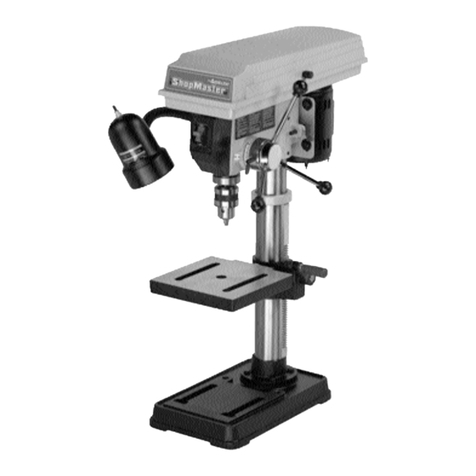
Delta
Delta ShopMaster 638517-00 User manual

Delta
Delta 37-280 User manual
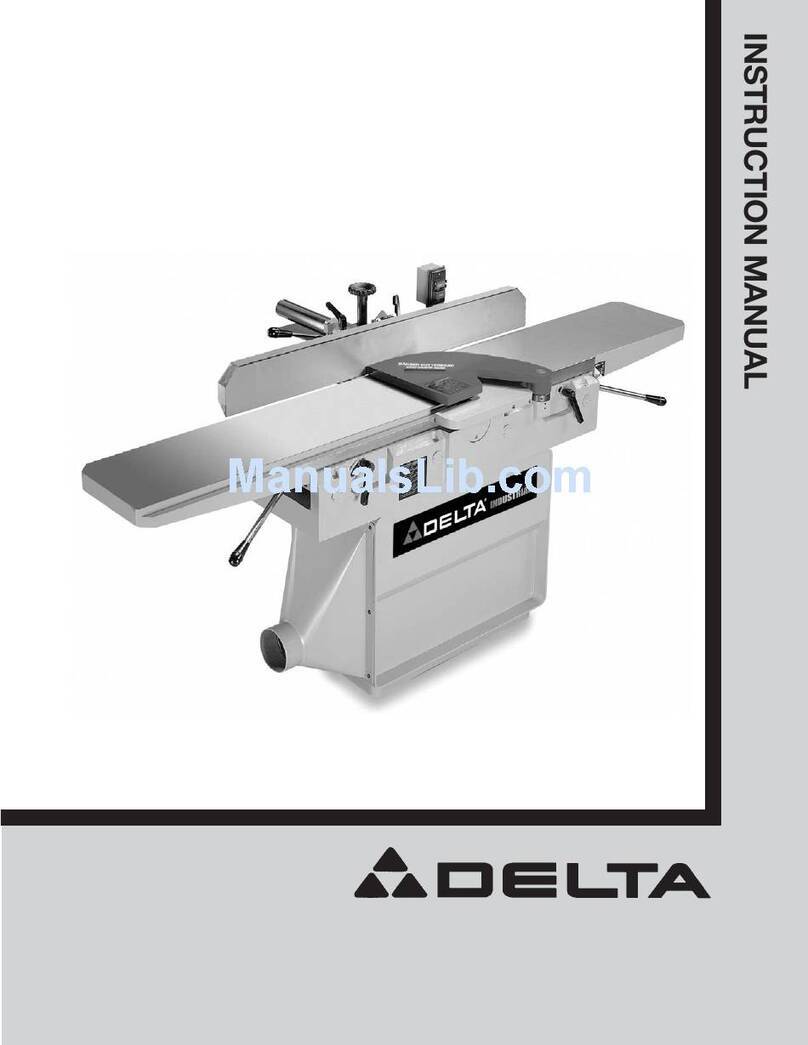
Delta
Delta 37-360 User manual
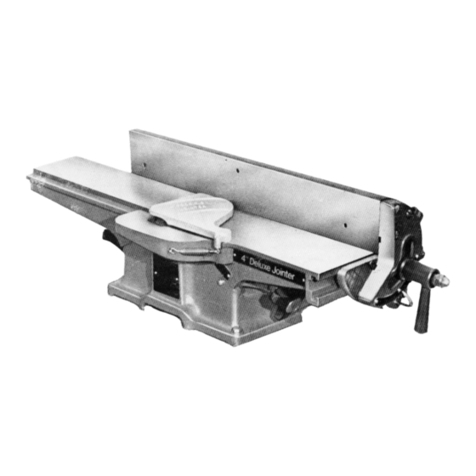
Delta
Delta 4'' Jointer User manual

Delta
Delta S Series User manual
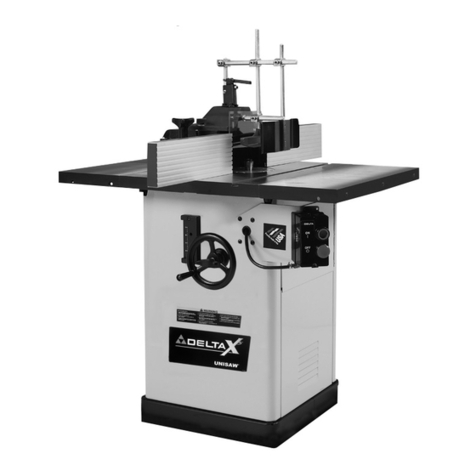
Delta
Delta 43-431 User manual
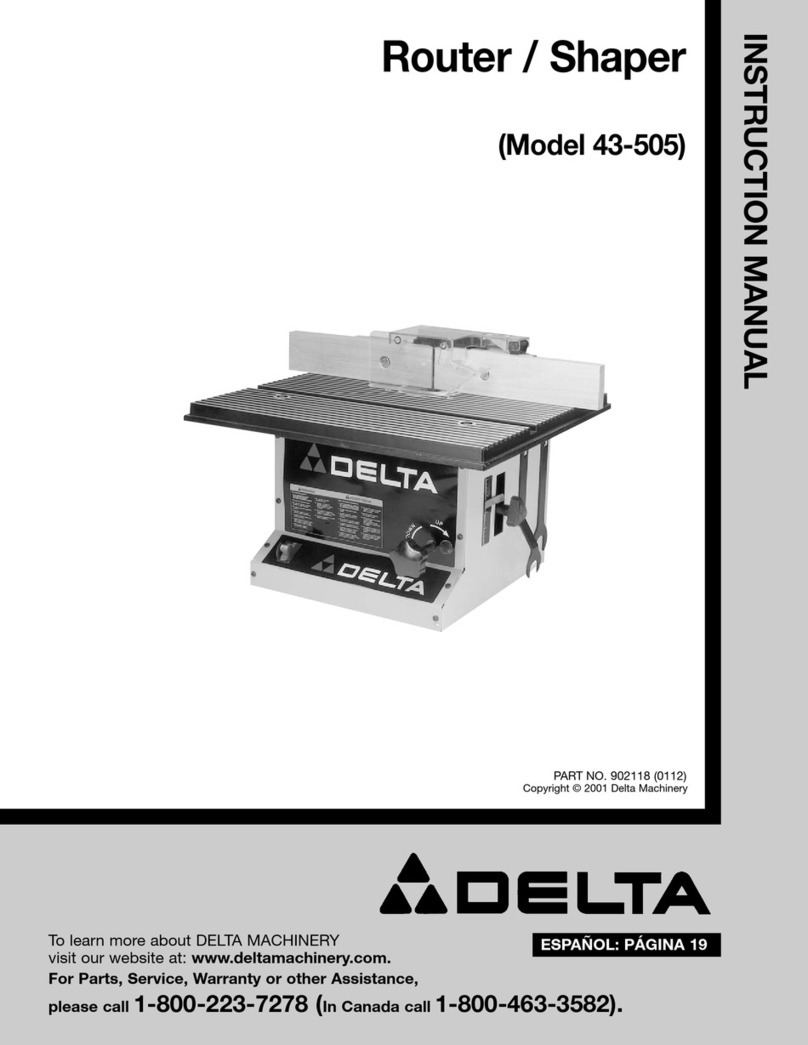
Delta
Delta 902118 43-505 User manual
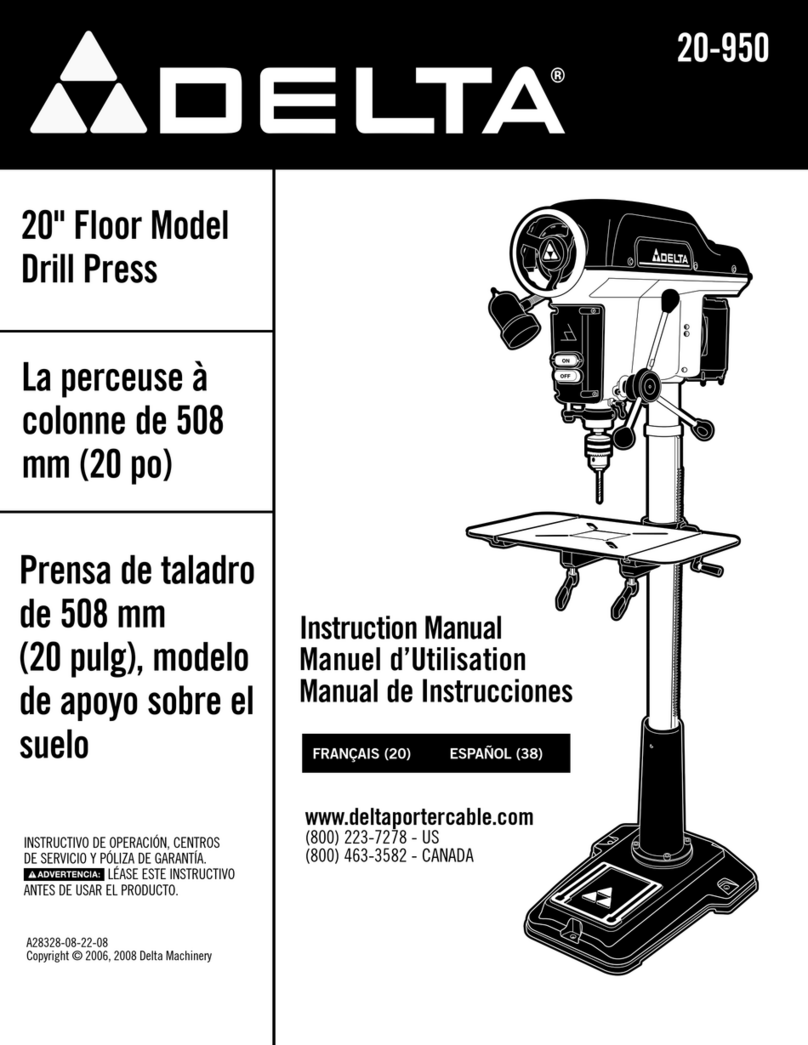
Delta
Delta 20-950 User manual
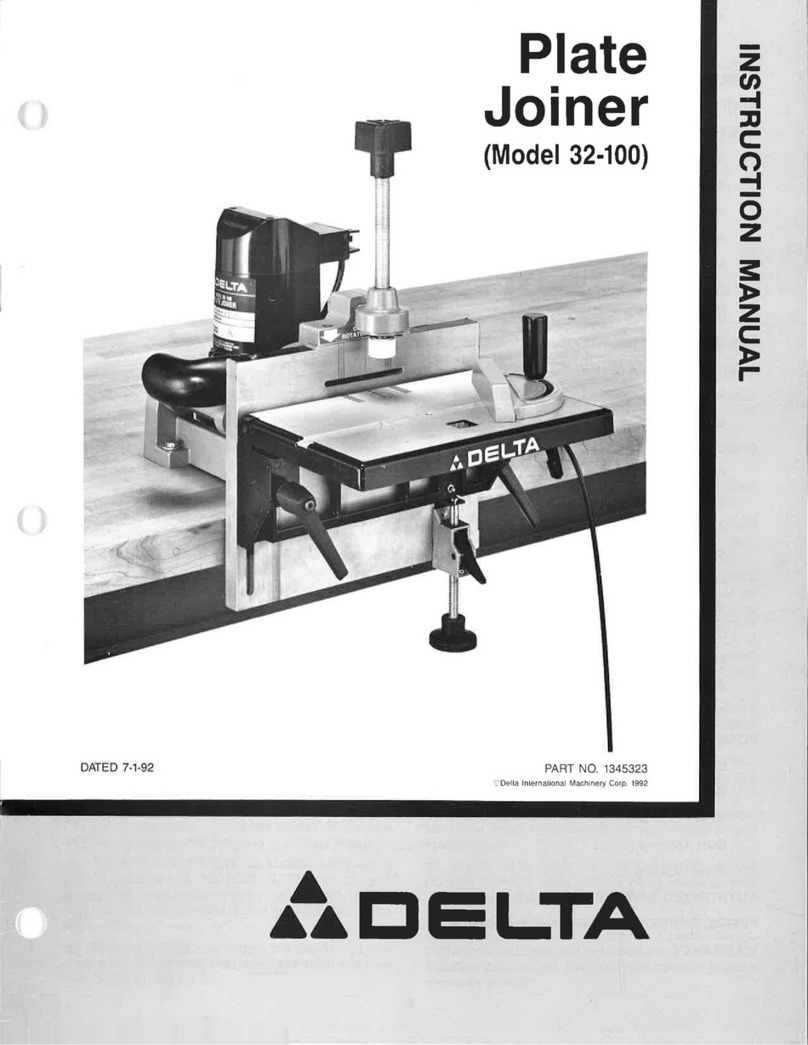
Delta
Delta 32-100 User manual
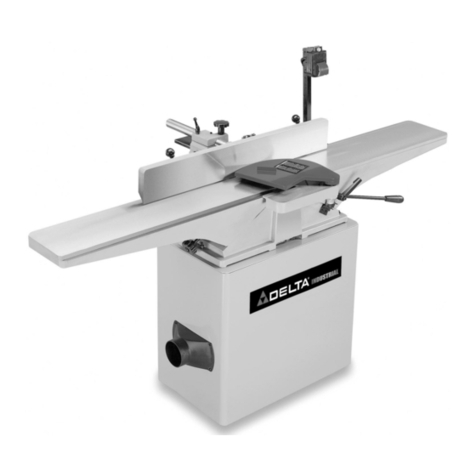
Delta
Delta 37-380 User manual
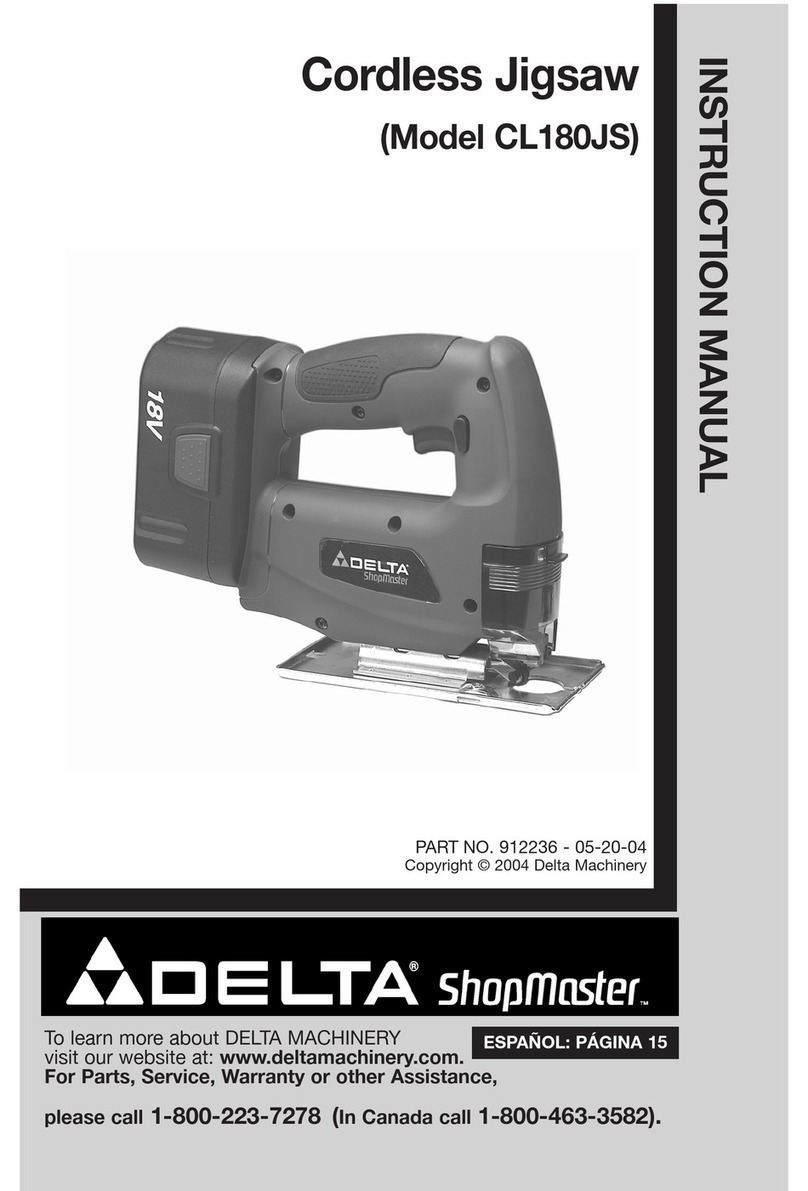
Delta
Delta ShopMaster CL180JS User manual
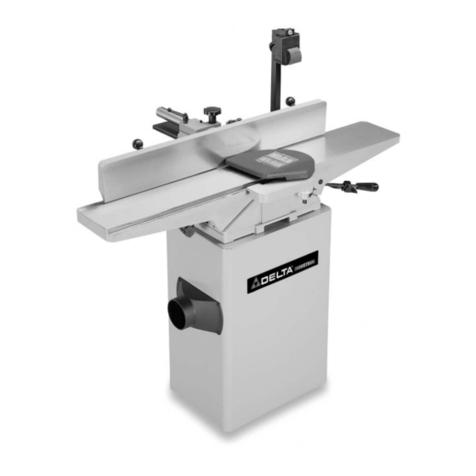
Delta
Delta 37-195 User manual
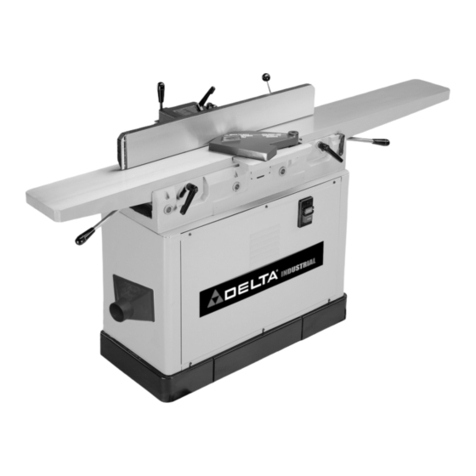
Delta
Delta DJ-20 Series User manual
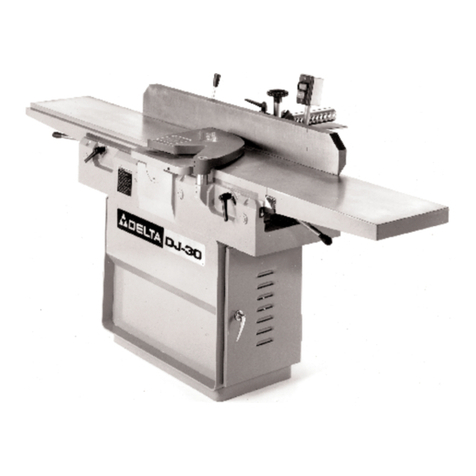
Delta
Delta DJ-30 User manual
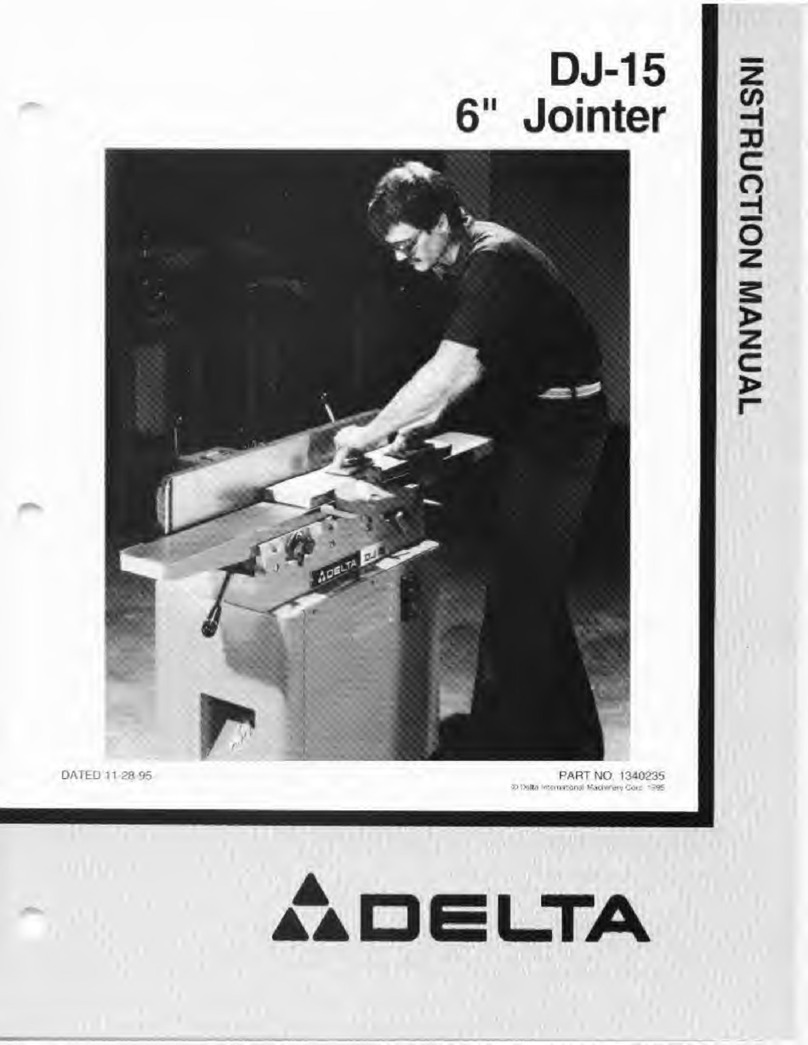
Delta
Delta DJ-15 User manual
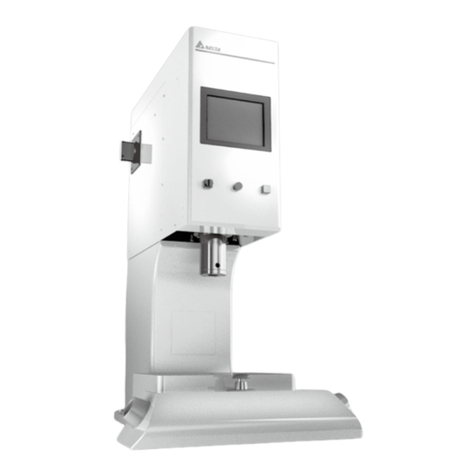
Delta
Delta S Series User manual
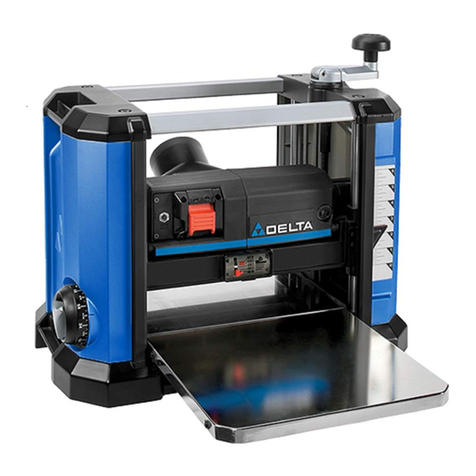
Delta
Delta 22-590X User manual
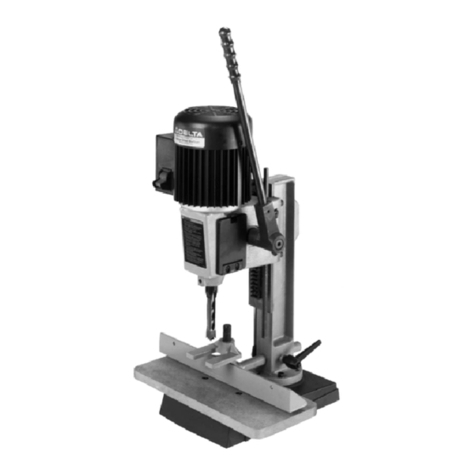
Delta
Delta 14-650 User manual
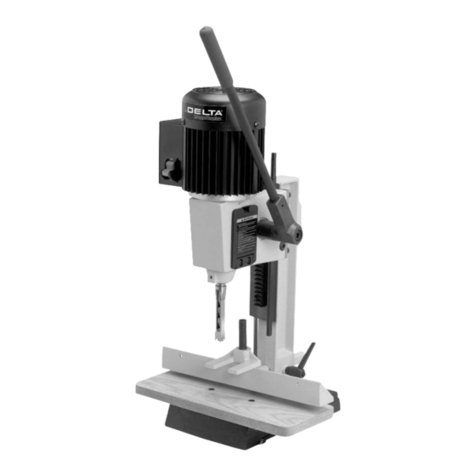
Delta
Delta ShopMaster MM300 User manual
